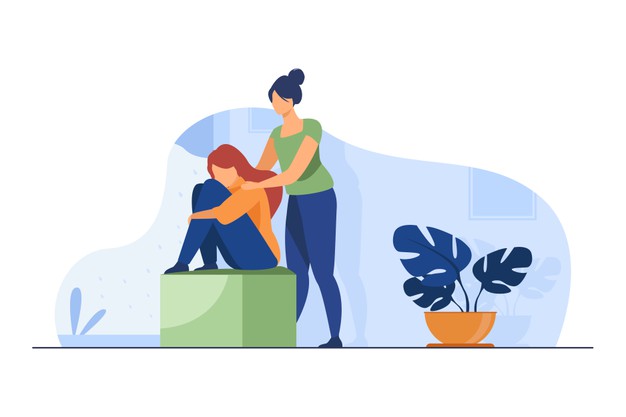Like most competitive Bay Area schools, our school has always seen mental health problems among students, particularly as they relate to academic pressure.
Throughout recent years, the district has taken notable measures in an effort to support students’ mental and emotional well-being — increasing CASSY’s presence on campus by moving it to the student center, hosting events like Breaking Down the Walls, implementing the HAERT modules during Wednesday advisory, etc.
Yet the WASC re-accreditation six years ago identified student mental health as one of our primary areas of growth, and the re-accreditation last year arrived at the same conclusion. Echoing their concerns, over the course of this past year, the number of parent calls to CASSY in the district increased by an astonishing 700 percent.
While this number is clearly correlated with the unusual stresses of the pandemic, online learning and the social and political crises of 2020, declining mental health among students has already been becoming more than a mere issue.
It is becoming a crisis.
And it is becoming a crisis because as a community, we have failed to properly address the deep-rooted issues that require work not just from the district, but from parents and students alike.
To fully understand the depth and complexity of this problem, it’s important to first examine the way many students have felt and why. As a disclaimer, I have zero credentials for psychoanalyzing students and cannot speak for all of my peers’ experiences; what follows is simply based on what I’ve felt and noticed from my peers throughout my 12 years of attending Saratoga schools.
On one level, you have the issues that come with vesting your self-image in academics and college admissions — a process that wears the facade of a meritocracy, exacerbating both the pressures students feel as they’re applying to college and the crushing sense of disappointment that comes when they receive less than ideal results. Parental and peer pressures worsen these feelings and can also contribute to a student placing unhealthy expectations on themselves.
Related to this overemphasis on academics and college is students’ internalized hustle culture, the equating of productivity to their self-worth and the reason so many students experience burnout.
Again, because of a combination of parental and peer pressure and the college admissions mania, from as early as late elementary school, some students come to believe that the number of difficult classes and activities they cram onto their plate somehow represents their value as people. But this isn’t all there is to the problem. Students generally feel heavy discomfort surrounding conversations about mental health even though so many of us struggle with such issues.
From what I’ve seen, in large part, this discomfort arises from external influences that can twist the idea of mental wellness. Parental pressures may drive students to invalidate their struggles or treat mental well-being as a mere price they have to pay for academic success and admissions to top colleges.
Students may also compare themselves to peers who seem to “have it all together,” which not only increases their lack of self-worth, but also causes them to invalidate their own feelings, convincing themselves they’re just “weak” for feeling stressed and low.
What’s so difficult about addressing these feelings is that they culminate over a lifetime. When students are constantly surrounded by forces that reinforce these pressures, they internalize all of these toxic ideas.
It’s no wonder, then, that despite their good intentions, the district’s measures have largely failed — they’re band-aids slapped over long-standing wounds that go far deeper than any one program or combination of programs can solve.
The 2018 Breaking Down the Walls event, for example, undoubtedly helped students be vulnerable with their peers, but within a few days, any effects of those experiences rapidly faded as students lacked the guidance and drive to continue fostering an open, emotionally honest environment.
As another example, the HAERT modules present valuable advice and insights that, if properly digested, can help a student learn to nurture their mental, emotional and even spiritual health. But the modules, designed in a simple video-quiz format, present information in an impersonal way, just like any other assignment, making it difficult for students to truly internalize the lessons.
By high school, it’s not as if students aren’t aware of the ways they can take care of their mental health, though the HAERT modules do present quite a variety of coping methods. Rather, students don’t feel the need to and don’t understand how to go about adjusting their mindsets and implementing these changes in their lives because they’ve never truly viewed their mental health as a top priority.
This is where the administrators, teachers, parents and students themselves all have to step in.
From what I’ve seen, many students feel a disconnect between themselves and the school when it comes to the latter’s attempts at supporting student mental health.
Part of this stems from the fact that the school officials’ actions sometimes fail to line up with their words. While they claim to care about students’ mental and emotional well-being, they continue greenlighting classes like AP Physics C and Advanced Science Research, leaving students to wonder whether they truly care about relieving academic pressure.
More importantly, the administration and staff should put greater effort into fostering a climate of genuine compassion on campus. This doesn’t happen through performative, one-time events or modules or grand speeches about how much the school cares about its students; rather, it happens through simple daily interactions.
This year, I’ve been fortunate to see many of my teachers actively checking in on their students’ mental health and reiterating that they’re there to support their students. If this trend continues, it can play a surprisingly large role in helping students remember that their mental and emotional health matter.
In the end, however, there’s only so much teachers and staff can — and should — do. Much of the burden of creating a mentally healthier climate falls onto the shoulders of parents and students themselves.
Take, for example, the opening of new courses. Although the administration can and should exercise their discretion in deciding whether to open AP courses, without student and parent pressure for more AP opportunities, the school wouldn’t have even considered opening these classes.
Students and parents, then, need to consider what they truly value: the college admissions mania or mental and emotional well-being?
Granted, these two options aren’t mutually exclusive; although difficult, it’s entirely possible to work hard and shoot for top colleges while taking care of yourself and recognizing that your worth isn’t vested in the university you attend. But until we start treating mental health as a real option, we can’t learn to let these two goals coexist.
To do this, parents need to play a more active role in creating safe spaces for their children to express how they feel.
Many parents talk to each other about their children’s accomplishments and proceed to tell their own children about how so-and-so’s child has started a nonprofit or taken 12 APs. Although parents may have no malintent, from a child’s perspective, listening to what other people are doing can create additional pressure.
Creating a safe space also includes more active interactions between parents and their students. From my experience, having my mother regularly check in on me and let me know when she’s concerned about me helps me feel cared for and more comfortable discussing my worries.
Although, like many other students, I don’t frequently discuss my mental health issues with my parents, they always listen to me when I do and validate my feelings instead of telling me I’m privileged and don’t deserve to complain — a common and destructive response that I’ve heard from some of my peers’ parents.
On several occasions, my parents have also reminded me that they care more about my happiness and well-being rather than the college I end up at, and these reassurances never fail to disperse, at least partially, the clouds of anxiety hanging over my head.
Of course, I’m not qualified to tell people how to parent, and some students may require more pushing from their parents. But even then, I’ve found that it’s important to find a balance between pushing a child and understanding that, in the end, their mental health still matters more than the university they attend.
Still, because students typically interact with each other more often than they do with their parents, they too have to take on a more active role in fostering a supportive climate with their peers. Saratoga High may not be as notoriously cutthroat as other Bay Area schools like Monta Vista, Palo Alto or Gunn, but there is an undoubtedly competitive climate that can sometimes become more toxic than productive.
Simple acts like checking in on a friend can show that you care for them, make them feel less alone and remind them of the significance of their mental and emotional well-being. One can take a variety of approaches to this; if I notice a friend seems a little off, for example, I simply tell them so, let them know that I wanted to make sure they’re OK and ask if there’s anything I can do for them.
Although people may feel less comfortable doing this with those who they aren’t as close with, the gesture can still go far. During a difficult period of my sophomore year, I received a message from an acquaintance who noticed I seemed really down, and her reaching out gave me some much-needed kindness and helped me feel less alone.
Actively listening to a friend talk when they’re upset and offering emotional support or advice (if they ask for it) can also help alleviate some of the emotional burdens they carry.
Because it’s difficult to be vulnerable with each other, I’ve also found it helps to first take a leap of faith and open up to a friend to show that you trust them; this strengthens your relationship with them and makes them more likely to confide in you as well.
And above all, students should take it upon themselves to practice self-compassion, to constantly remind themselves that they need to take breaks when they feel overwhelmed, that they are not inferior to their peers just because they “accomplish” less, that they have the qualities to succeed and find joy in life.
Addressing student mental health is clearly a complex issue. Until we all begin to genuinely acknowledge its breadth and depth and foster a more compassionate environment, mental health problems will remain a perpetual cloud hanging over the school.


























